I started ingesting Jaime’s work through osmosis when I was a little kid hanging out in the back of my father’s comic book store — images in ads, articles, seeing the covers of his books on shelves, hearing conversations about Maggie and Hopey. Love and Rockets was an aesthetic space that existed for me in the abstract long before I ever read the comics themselves. (In one sense, that adds a layer of truth to Noah’s assertions re: nostalgia, in that the Locas stories all bring me a nostalgia for the mysterious allure they exerted on my young mind before I’d read them. I get wistful just looking at their cover fonts!)
Despite being around Love and Rockets comics since an early age, I didn’t read any of it until much, much later, and I didn’t start at the beginning. The first comic by Jaime Hernandez I ever read was “Flies on the Ceiling,” which still ranks among the most astonishing comics works I’ve ever laid eyes on.
Most of the elements that make Jaime one of my favorite cartoonists are present in “Flies on the Ceiling”:
– the achingly beautiful drawings that find the perfect mixture of realism and cartooniness, seemingly effortless in pulling from the best of both worlds
– the breathtakingly controlled compositions, with their deep blacks and bright whites, attention to both diegetic space and abstract negative space to create enviromental
verisimilitude and broad visual dialectics at the same time
– the ability to draw the most nuanced facial expressions in the history of comics, and to know exactly when to give them up for broad caricature
And, above all: the gaps.
Reading a Jaime comic brings to mind the old cliche about listening to Jazz – “It’s not about the notes they play, it’s about the notes they DON’T play.” Jaime’s work is full of sudden narrative gaps – abrupt jump cuts and unexplained transitions that, for me, are the most exciting element of the reading experience. I get a rush whenever my brain has to reconcile two disparate moments next to each other on the page. This page from “Flies on the Ceiling” is one my favorite comics pages of all time:
There’s another kind of exciting narrative gap in Jaime’s work, which has most recently been cited as the cartoonist’s greatest flaw by Robert Stanley Martin in his essay for the roundtable: the persistent referencing of past or future events between Locas stories.
As I said, my first Locas story was “Flies on the Ceiling,” which coincidentally Martin uses as his prime example of what he thinks doesn’t work in Hernandez’s stuff. Rather witheringly, he writes, “as anyone who’s been around a Trekkie knows, fannish types place particular value on details and resonances that casual audiences either miss or don’t understand. It’s sad that Hernandez, with all his talent, undercuts his work by catering to this proclivity at a larger readership’s expense.”
Now, I don’t know that I’m a casual audience (though my gut suggests I may qualify as a large readership), but I do know this: when I first read “Flies,” I could absolutely tell that there were details and resonances that I wasn’t fully understanding – and I considered that a feature, rather than a bug. There was already so much to tease out of the dense and fragmented structure of the story that it made perfect sense to me to also have to ponder after unexplained history. I enjoyed the friction of the unknown.
Similarly, and maybe more pertinent to the Locas stories as a whole (“Flies on the Ceiling” being in many ways a stylistic outlier), I read “Ninety-Three Million Miles from the Sun” with only a cursory non-textual idea of who Maggie and Hopey were, and no familiarity with any of the other characters aside from seeing the covers to some of the Penny Century comics. And I loved it – maybe as much for what I was missing as for what was there. The vibrancy of the characters and the visual mastery of the art was complemented by the vast ocean of story that appeared to float just beyond my reach, hinted at throughout but never fully explained.
And let me be clear: I’m not saying that I was excited because I knew there was a huge backstory that I could eventually catch up on. I was excited by the suggested existence of backstory that as far as I was concerned may or may not actually exist as drawn stories. What I respond to the most in Jaime’s work is the gap between the captured moment and the suggested context. This sequence from “Ninety-Three Million Miles” (this is the entire sequence, by the way – an example of Jaime’s abrupt cutting) encapsulates everything I love about Jaime’s work not already on display in the earlier page from “Flies.” The mixture of realism and cartoon tropes, the chaotic, fun, and funny relationships between characters, and the embedding of this moment in an unseen narrative context.
Even now, having read most of his work, there are still beautiful absences in the narrative understanding Jaime offers. One is the strange genre territory the Locas universe sits in, where someone like H.R. Costigan can exist alongside Ray Dominguez, where there can be rocket ships and super heroes and a mansion with 1000 rooms, and also the streets of Hoppers. Another is that, despite a voluminous body of work, Jaime has yet to exhaust the pasts or futures of his characters – witness the pairing of “Browntown” and “The Love Bunglers,” or the Lil’ Hopey sections embedded in “The Education of Hopey Glass” (the next book I read after “Ninety-Three Million Miles,” if you want to further chart the perversity of my Hernandez timeline). There are still things we can wonder after.
In theory, I understand that the continuity and references might keep some people from enjoying the work because they think that they’re missing something. But in practice, I have a hard time really accepting that as a legitimate complaint about LOCAS. For me, Jaime’s work isn’t a continuous narrative to be ingested in order and “properly understood.” It’s a web of moments, interconnected but not interdependent. Noah’s right in his article on nostalgia that “simply knowing there’s a whole is itself a delight,” but I think he misses (or simply disagrees) that the moments themselves are also a delight, and that the moments exist in a constant tension with the unseen whole that provides something more than merely nostalgia.
I think part of the reason Jaime’s work functions this way for me is the much-ballyhooed “realism” of his characters. I’ve lost track of what everyone means by “real” or “authentic” in these discussions, so to clarify: I mean that the characters in LOCAS exhibit an emotional verisimilitude that convinces me above and beyond suspension of disbelief for the purposes of a story that they “exist” in some way. Jaime’s mastery of body language and facial expression is part of it, as is his finding that sweet spot between specific realistic draftsmanship and universal cartoonish simplicity. But it’s also in the way his characters act towards one another, the way they speak in the sometimes-clunky but always genuine dialogue. There’s no good way to put it that doesn’t sound fannish or essentialist, but Jaime’s characters just convince me. So much so that in any given moment of a Hernandez comic, I feel as if I’m stealing a glimpse of a fully formed reality, the rest of which is just concealed from view.
(I know Caro has asked, rhetorically, why “real” should count as an inherent positive quality of a fictional character when we are all surrounded by actually real people who would be more deserving of our attention if what we’re looking for is emotional verisimilitude. To me, this is a false equivalency. A person is a person and a character is a character. I don’t watch my friends and family with an omnipotent eye for my own entertainment. There are inherent responsibilities and detachments, different empathies that come into play, interacting with a fellow real human being. The purpose of a “real” character isn’t to supplant real life, but to reflect it, offering you a way of experiencing and thinking about people that actual people can’t ever supply. Conversely, real people offer experiences that fiction can never supply. That’s why we need BOTH.)
(I also don’t quite understand or believe Caro’s comment that “Emotional verisimilitude and compelling characters and being real are just the bare minimum I expect of competent fiction. It’s not what gets you praised; it’s what gets you published.” There’s a difference between a character being well realized enough for you to go along with a story; another for you to be truly convinced of the character’s inner life. If the latter is really as ubiquitous as she seems to imply, then she exists in a literary universe I am unfamiliar with.)
Lastly (and this is a point too important to bury at the end of an overly long and discombobulated essay, but here I go anyway) Jaime’s work sends me because I have an inherent love for the aesthetic of comics themselves, and his comics exalt those aesthetics. This is a position our host tends to disagree with – it seems (and Noah, please correct me) that he places more value on plot and character choices independent of form than on the ways in which formal choices craft plot and character. I camp out on the opposite side of that formulation. For example, in his Jaime essay, Noah called attention to this two-panel sequence in order to say of it, “You see Maggie from a distance, and then in close up. It’s not an especially interesting or involving visual sequence…”
Whereas, to me, there’s a wealth of information in these two panels. In the first panel, Calvin is standing between the young kids and the young adults. He’s clearly apart from both, but he’s turning away from youth and facing a sexually fraught tableau – his blossoming older sister flirting with his rapist. The dark shadows on the underside of the tree make the scene in the distance forbidding but also contrasts with and then highlights the two figures below. The second panel is dramatic not for its shifting perspective, and not for the readers seeing Maggie as post-pubescent for the first time (as Noah posits), but for Calvin seeing his sister as a complex and somewhat frightening part of a world he doesn’t understand but which causes him pain and humiliation. It’s Calvin seeing the laughter in her eyes next to the older boy, and it’s the dismissiveness of her words cast against Calvin’s confused feelings of jealousy and protectiveness towards her. These are all present in the form itself, and are inseperable from the content.
The greatness of Jaime’s characters and storytelling has as much to do with the way his drawings exist on the page as with the particulars of his plots. To me, there is joyful aesthetic purpose in characters existing inside stark black-and-white fields, in characters existing simultaneously as realistic and cartoonish, and in the composition and arrangement of images on a page to create a sense of movement and life. These elements are just as much a part of “who” these characters “are” as their actions within the plots they inhabit. Just spending time with these drawings – with these characters (same thing) – is enough for me to say that Jaime is one of the best.
___________
The index to the Locas Roundtable is here.

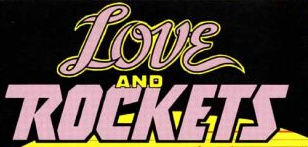
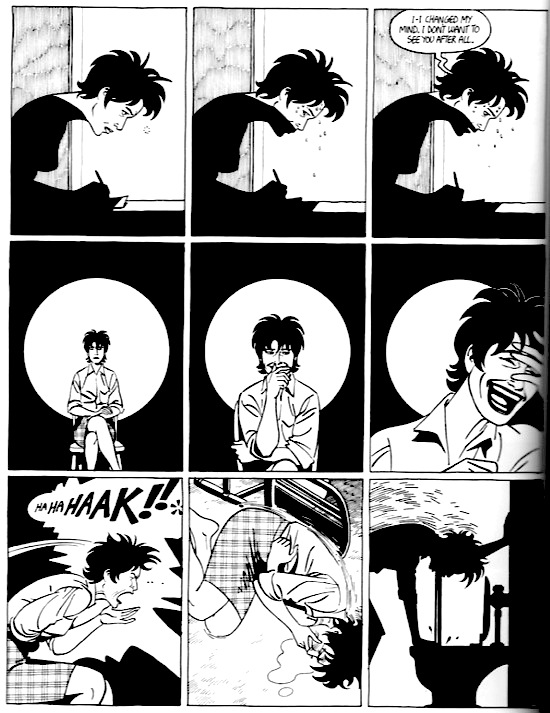
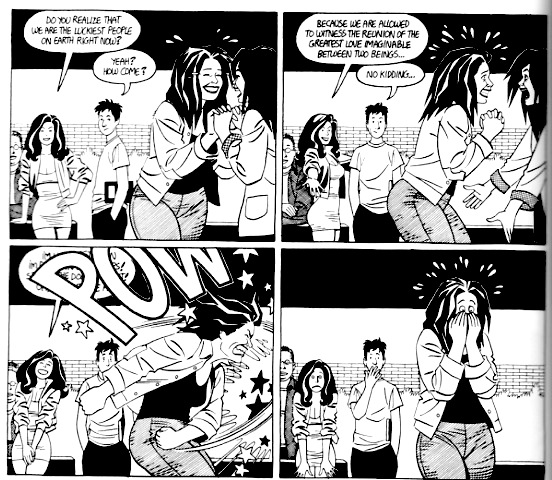
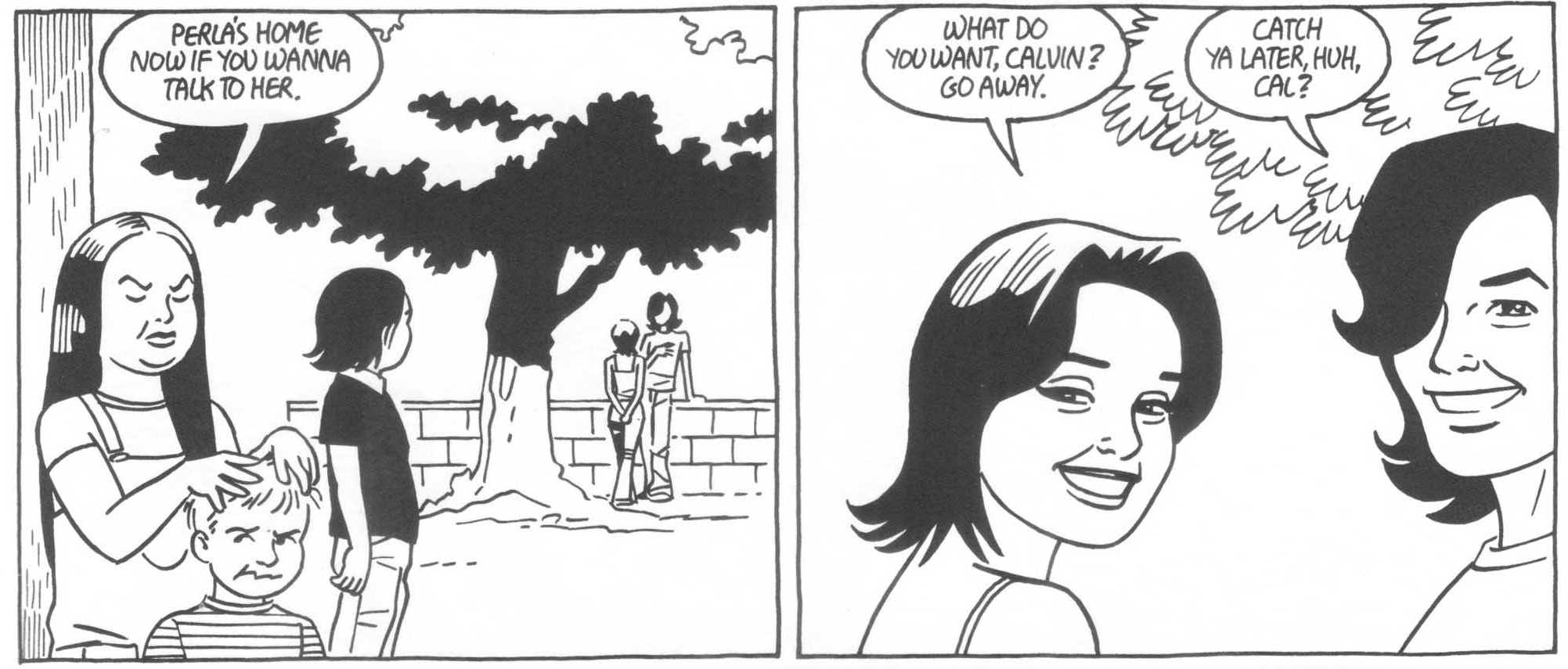
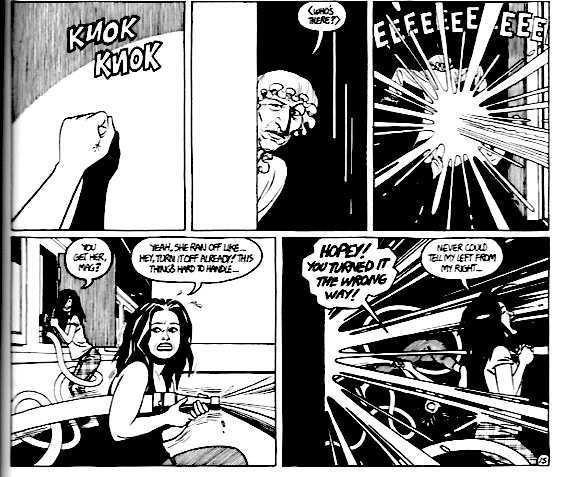
“Caro– Emotional verisimilitude and compelling characters and being real are just the bare minimum I expect of competent fiction. It’s not what gets you praised; it’s what gets you published.”
Well, it does get you published- sometimes. Not always. A lot of times doing the opposite of that just might get you published.
“Jason-The persistent referencing of past or future events between Locas stories.”
And a qualification- the “easter egg” references in JH’s stories aren’t necessarily constant. It depends on the story. Some much more than others.
Nicely said. The only thing is that I can’t see this jealousy that keeps being mentioned in regard to Calvin. He’s not jealous of Maggie in relationship to his rapist or of his rapist in relation to her. He’s hating that his rapist is near his sister.
I mean, the characters drawn by Jaime, of course.
In the panel on the left above Calvin is with other children who are just being kids, the little girl with her ridiculous expression massaging the other kid’s hair. But Calvin has been to forced to grow up fast. In the right panel his rapist and Maggie are glamorized, as Maggie does a typical big-sister blowoff and the rapist actually says in front of her the truth and it’s a threat and a promise…he will be seeing Cal later.
Robert Stanley Martin wrote the following in comments re: Flies on the Ceiling. I think it’s pertinent to Jason’s own reading experience:
The ending of “Flies” is designed around a fairly obscure reference to an incidental scene from an earlier piece. The protagonist of “Flies on the Ceiling” is not a principal character in either that earlier effort or the Locas material as a whole. Additionally, Hernandez is relying on knowledge of a couple of panels from an even earlier story for the reader to recognize the character. For these and other reasons, I think Hernandez is going way beyond requiring a basic grasp of the back story. He’s demanding a fairly obsessive knowledge of his prior œuvre. It’s as if Proust, in Book Five of In Search of Lost Time, stuck in a story about the early life of Françoise the maid that used a few sentences in Book One as a starting point and relied on a reference to a minor scene in Book Three for the resonance of its ending. I don’t recall Proust coming close to doing something that extreme, and he’d deserve complaint if he did, especially if that story enjoyed the status among Proust’s readership that “Flies on the Ceiling” does with Hernandez’s.
The ending of “Flies” is an example of where Hernandez’s Easter-egg storytelling outright sabotages the story. It’s kind of anomalous in that. With most of the material I’ve read, the Easter eggs tend to be the most interesting thing about them. There are pieces that are exceptions, some of which I’ve noted, but on the whole the narratives are shapeless and the characters lack dynamism. That’s not the case with Proust, who consistently interrogates the ironies in his characters, crafts his individual scenes with clear effects in mind, and has those scenes build to a larger cumulative whole. Hernandez appears so captivated by his characters’ personalities that he doesn’t treat any of that as necessary. As I said in the piece, the main thread of Locas reminds me of a reality TV show. There’s no real narrative arc being developed; it’s just a continually updated account of the people being depicted. That certainly works for a number of readers. It doesn’t for me, although I do think there is an aesthetic basis for my disdain.
Concerning the 2 panels being discussed by Jason/James above: I think it’s also a mirroring sequence, something which occurs a bit more often in the recent Locas stories. As an artist, Jaime has an acute control over the physiognomy and facial features of his characters, and Maggie’s appearance here is probably meant to foreshadow Esther’s own appearance when she grows up (as seen in the top tier of this linked image) . The sisters actually look quite similar (at various points in their lives) and this is clearly intentional.
Jason, your comments come closer than anything else I have read to describing my own feelings about /Locas/.
There’s no real narrative arc being developed; it’s just a continually updated account of the people being depicted.
Not so. The great Jaime Hernandez stories (and “Flies on the Ceiling” is emphatically one of them) possess an internal consistency and crystalline formal and aesthetic unity that makes them noteworthy and powerful on their own terms. The idea that JH is just artlessly spinning in the orbit of favored characters is a canard that is belied by the brilliant narrative shaping of stories like “Wig Wam Bam” (boldly shaped around the lead charcters’ absence!) and, yes, “Flies on the Ceiling.”
The claim that the characters lack “dynamism” is also a canard. What the characters lack is the reassuring sense that they will do something heroic that entirely transforms their lives, their circumstances. They don’t. But that doesn’t mean they lack the capacity for meaningful change.
I think these comments rhetorically construct JH as naive and in thrall to soap opera/comic book conventions. That’s a very reductive characterization in my view.
PS. I should clarify that I think Jason’s post itself is excellent. I was targeting only a particular reader comment.
James – I don’t see any reason why there can’t be, or why there isn’t likely to be, both. Calvin obviously hates his rapist but he was also attracted to him at one point, on some level, and sexual abuse creates very complex, confusing sets of thoughts and feelings. The constant abuse is horrible, but in a way it’s also Calvin’s “thing,” his first foray into sexuality and adult attention. Later in the story, when he screams “You said just me!”, his anger is stemming from protectiveness of Maggie, but also I think clearly from jealousy, and also from the guilt he feels from having “asked for it” and started the cycle of abuse (in his mind). Seeing Maggie as sexually threatening/frightening is part of why Calvin still can’t talk to her as an adult. He loves her, he wants to protect her, but he is still intimidated by her, and the part of him that would learn to process adult relationships has been irrevocably broken.
Charles–
I’m going to post your comment over at the thread for my essay. What you’re responding to wasn’t written for the context of this thread. I’m fine with Suat posting that comment over here, but if someone is going to reply to me exclusively, I think it’s best that we have that discussion in the thread following my essay. If you haven’t read that piece or the accompanying thread, I’d appreciate your taking time out to do so.
I’ll respond either tonight or tomorrow. If you have anything you’d like to add before then, please do. Thanks.
Jason: To my eyes, Calvin early on perhaps looks up to the unnamed bigger kid and wants to be part of the group, but that does not mean that he in any way thinks he “asked for” being repeatedly buggered. The right panel of the two above is drawn from Calvin’s POV, he sees Maggie and that kid as beautiful, as little children will see older teenagers, but he knows exactly what ugliness underlies his rapist’s appearance. And I don’t see Calvin as sexually attacted to Maggie, he loves her as his sister.
James – again, I don’t think that what you’re describing and what I’m describing are mutually exclusive. Calvin can love Maggie as his older sister and still be intimidated and confused by her sexual attractiveness. That’s a pretty common psychological event, if I’m not mistaken.
Particularly because Calvin’s relationship to sex at this point is so thoroughly debased and confused that he would have all sorts of conflicting feelings that he doesn’t understand fully.
My response to Charles is here.
I’m glad you put up the examples you did; it is interesting how the right hand panel, the glamorized POV shot, complicates reading—Jaime here wants us to see how Calvin is percieving what is going on…none of this is accidental
“I think these comments rhetorically construct JH as naive and in thrall to soap opera/comic book conventions. That’s a very reductive characterization in my view.”
Maybe he’s not always in thrall to those conventions. But he is at least some of the time. The awkward twists from the past few volumes and that goofy “secret marriage” from the “Penny Century” book come to mind.
“Not so. The great Jaime Hernandez stories (and “Flies on the Ceiling” is emphatically one of them) possess an internal consistency and crystalline formal and aesthetic unity that makes them noteworthy and powerful on their own terms.”
“Narrative arc” implies that there’s a finality, a true ending to the story. Many times JH has hedged his bets, like with “Ghost of Hoppers” and apparently with vol. 4 where the “arc” is left ambigious for purposes of revisiting the characters somewhere down the line.